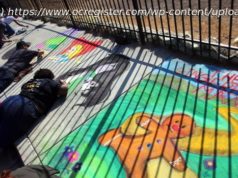The canine’s presence seems to set off an ecological ripple effect.
Stretching across some of the most remote, arid places on Earth is one of humanity’s largest built objects: the “dog fence,” a nearly 3,500-mile-long barrier erected to keep wild dingoes away from the sheep that graze on some of Australia’s most populated regions.
Up close, the fence isn’t much to look at: four feet high or so, made out of chickenwire, lying like a long metal snake across the red sand of the desert. But it’s responsible for a newly discovered ecological phenomenon. By keeping dingoes out of the southeastern part of the country, it has created two versions of the same landscape—a world with top predators and one without. And you can feel the difference in your feet.
Mike Letnic, a field ecologist in sunglasses, shorts, and a battered felt hat, has spent years crisscrossing the dog fence when not at his desk at the University of New South Wales in Sydney. For a long time, he felt that the landscape was clearly different on the two sides of the fence, but “it was very hard to put a finger on it,” he says. Eventually, he realized that on the side of the fence without dingoes, the desert sand was mounded into tall dunes with plants growing on their crests. On the side with the tawny canines, vegetation was sparser, and dunes were bald and short and prone to shift under his boots.
“It is a little bit harder to walk on the dingo side because the sand is looser. You do a lot more trudging,” Letnic says. On the other hand, it is also “easier to see” because there are fewer trees and bushes.
Last year, Letnic decided to see if he could get to the bottom of this mysterious discrepancy. He and his colleagues flew quadcopter drones over the desert in Sturt National Park, choosing a spot where for the past 40 years the only real difference has been the dingoes, taking photos of 12 dunes on both sides of the fence.
Next, they stitched together photos taken from different angles to create a 3-D model of the landscape, showing its contours. By digitally removing the vegetation, they were able to measure the height and angle of the underlying dunes. They report this week in the Journal of the Royal Society Interface that dunes on the dingo-free side of the fence are on average 66 centimeters higher. The presence or absence of dingoes, it seemed, was changing the very shape of the land.
Letnic and his team propose that the removal of dingoes has caused an ecological ripple effect. In many arid Australian environments, dingoes kill cats and foxes—two smaller predators introduced to the continent after European settlement in 1788— to get rid of competition. (The dingoes prefer kangaroos for actual meals.) This reduction makes life easier for the cats’ and foxes’ prey: small desert mammals like the dusky hopping mouse and the rabbit that dingoes generally don’t bother with. When these small mammals grow in numbers, they eat more seedlings and seeds of desert plants like hopbush and marpoo. Without plants to slow the wind and bind the sand with their roots, dunes get flattened and scattered.
On the other side of the fence, the relationships appear to work the other way. Fewer dingoes leads to more cats and foxes, which leads to fewer little mammals, which leads to more shrubs, which break the wind and stabilize the sand with their roots, allowing taller, stable, vegetated dunes to form.
So which state of affairs is better? Letnic says that is a value judgment he leaves to others. “It is very hard to say what is good or bad, particularly because Australia has such a modified ecology,” he says. Since European arrival, the introduction of cats, foxes, rabbits, cane toads, sheep, cattle, camels, and other species has wildly rearranged the ecology of the whole continent.
The University of Tasmania ecologist Chris Johnson says the experiment is “one of what is still a small handful of studies worldwide that have shown how the effects of top predators reach all the way to the physical shape of the land itself.” Studies in Yellowstone National Park have suggested that the reintroduction of wolves reduced elk numbers and changed their behavior, which in turn allowed some vegetation to reestablish, which then influenced the shape and speed of rivers. But that story has been questioned by a series of studies that don’t show a clear change in the park’s vegetation—or that fear keeps elk completely out of certain areas. Meanwhile, hunting pressure, drought, and other factors also reduced elk numbers. Nothing is ever straightforward in ecology.
Dingoes came to Australia thousands of years ago with people, but even when they spend their puppyhood as pets they often return to the wild upon maturity. Aboriginal people historically collaborated with the animals to find water, stay warm on cold desert nights, and hunt. Women even commonly nursed dingo pups. These days, dingoes are more likely to be poisoned or shot than suckled, and their propensity to eat lambs has earned them the undying ire of many pastoralists, who tend to dismissively refer to them as “wild dogs.”
But ecologists in Australia are increasingly calling for the canines to be considered a rightful part of the country’s wildlife, especially since they can help control cats and foxes, which have been implicated in many of the 30 extinctions of the country’s native animals since 1788. Most recently, the Dja Wurrung Aboriginal community has released plans to return dingoes—or Gal in their language—to six parks and reserves in the Australian state of Victoria, in part to protect small native animals.






